Executive Summary
There is an immediate need to build large airports in many developing countries to promote economic development and city building. When airport construction is currently underway, whether it is the construction of a new airport or the expansion of an existing one, the feasibility of the airport construction is studied, and a feasibility study is provided; however, the feasibility study is unable to quantify the environmental impact of the project, which affects the decision making of investors and decision-makers on the ecological cost of the project. The study of monetized environmental costs can help clarify airport construction’s ecological impacts. The article introduces the research results on the environmental cost of engineering construction at home and abroad. Based on the existing research, the environmental cost of airport construction and Operation comprises six categories: noise, water pollution, soil erosion, land use change, vegetation destruction, and greenhouse gas. In the second part of the paper, the monetization models for the construction and operation periods of the airport are discussed using the alternative market approach, the human capital approach, and the protection expenditure approach. In the second part of the paper, the environmental cost of the third phase expansion of Baiyun International Airport in Guangzhou, Guangdong Province, China, is calculated to be $3,240,957,820 for the entire construction period and $2,395,540 per year for the operational period.
Keywords: Monetization; Airport construction;Environmental Costs
Introduction
Research Background
Much of the world is experiencing rapid urbanization. Not surprisingly, rapid economic development accompanied by rising transport demand has led many cities to build new airports or expand existing ones. The Chinese government plans to increase its urbanization level to 60% by 2030 and construct thirty-one airports in one year from 2021(Guo, 2017). Rapid developments such as airport construction have adverse environmental impacts, requiring environmental regulators to impose pollution tax on the developers (Sipping et al., 2019). Airport construction often has irreversible ecological impacts, such as soil erosion during construction and noise pollution to nearby residents during Operation. Research shows detrimental air quality and environmental effects emanating from airport construction and operations (Arter et al., 2022; Ashok, Dedoussi &Yim, 2014). Several researchers have adopted the concept of monetizing the impacts to estimate the actual environmental impacts of airports. For example, in their study, Artel et al. (2022, p. 10) found that quantified air quality effects during aircraft landing and takeoff operations (L.T.O.)-attributable PM2.5 and NO2 premature mortalities increased by 10% and 80%, respectively, from 2011 to 2016. NO2-attributable premature mortalities are responsible for 91% of total LTO-attributable premature mortalities in both 2011 and 2016. Even though the quantities of premature mortalities were identified, there was a gap in determining the costs necessary to compensate the affected persons from the L.T.O. activities.
Environmental economists’ tasks are quantifying and monetizing the ecological costs to compensate the affected communities through establishing recreation sites, engaging in environmental conservation projects, and giving back to the affected districts through corporate social responsibility guidelines. The massive airport construction and operations in China should be quantified and monetized to help the affected sectors recover their environmental regulatory services. Implementing environmental policies such as the polluter pay principles becomes a reality once the ecological costs are accessible and accurate. Therefore, this study investigates the systematic monetization model analysis of the environmental costs of airport construction and operation periods.
Research Aims And Objectives Of The Study
The study aims to investigate the systematic monetization model analysis of the environmental costs of airport construction and operation periods.
This study adopted the following objectives;
- To determine the environmental costs of airport construction and operation period.
- To determine how monetized ecological costs can help clarify airport construction’s ecological impacts.
Literature Review
Overview of the evolution of monetization methods
In 2005, researchers introduced a concept called “social indicators” to link the adverse impacts of construction activities to assessment methods. They considered 22 socio-environmental project-related and seven ways in economics and actuarial science to quantify specific social costs associated with construction projects (Gilchrist and Allouche, 2005). This sets the stage for the monetization of construction activities.
After a decade of development, monetization methods have gradually developed. Pizzol et al. (2015) summarized the types of currency valuation methods (table 1) and summarised each currency valuation method’s essential features, advantages and disadvantages. Finally, currency valuation methods are evaluated against a comprehensive set of criteria, ranging from scientific basis to uncertainty and complexity.

These monetization methods are used in calculating environmental costs in various fields. Later, researchers found that some areas needed different monetization methods, and many parameters and variables were required to be considered in the calculation process, so various monetization analysis models were developed. Arendt et al. (2020) compared the relevant monetization analysis models, namely Ecovalue12, Stepwise2006, LIME3 and nine other environmental monetization analysis models (table 2), and proposed that practitioners should choose their monetization method carefully and use different ways where possible to assess the robustness of its results.

These monetization analysis models are regional. In other words, these models are limited depending on regions’ or countries’ economic situations or policy requirements.
A review of monetization research in similar fields
Monetization is more mature in the field of road construction projects. (Bein and Kawczynski, 1997) Proposed the concept of monetization of the social cost of roads. Dai (2011) presents his study’s findings on monetizing external road costs. The study divides the environmental costs of road transport development into three categories: ecological impacts, environmental pollution, and greenhouse gas emissions. Using the theoretical basis of ecological economics, a model is proposed to estimate the environmental impact of road traffic, ecological pollution and monetization methods of greenhouse gas emissions, and the model is used to calculate the environmental cost of road construction and Operation of a highway for the project 7.31% of the total investment. This study proposes an initial model for monetizing the environmental impact of road construction, which needs to be completed because the survey does not include all ecological and environmental effects.
Besides, Yao et al. (2020) adopted field research and building information modelling (BIM) methods to collect data in road construction engineering. They proposed a life cycle assessment (L.C.A.) model, namely the input-process-output model (I.P.O.), from the four life cycle stages of transportation, stacking, assembly and cast-in-place to analyze the construction environment impact of standard floors of industrialized buildings. The results show that among the four life cycle stages, the assembly stage has the most significant impact on the environment, accounting for 66.13%, followed by transportation, accounting for 16.39%, stacking, accounting for 10.29%, and cast-in-place accounting for 7.19%. The study analyzed the degree of the environmental impact of each life cycle stage from other perspectives. The research results have extensively promoted the monetization of the environmental impact of buildings. Still, this study has significant limitations because the research results only apply to the construction of the standard layer of the building and only apply to other types of construction.
Environmental monetization is carried out from different angles in the research of related fields. For example, Dai’s analysis starts from the various ecological costs of engineering, and Yao’s research institutes from the different periods of architecture as the research direction. Carrying out research from different angles has different meanings, and the current mainstream research is still carried out with other environmental costs.
Current Status of Research on the Monetization of Environmental Impact of Airport Construction
Airport construction and Operation is one of the critical areas of current research. The growth and expansion of the aviation industry have attracted the construction of new airports and the renovation of old airports and airstrips. Although the development of the aviation industry stimulated economic growth and provided jobs, the environmental impact of the entire project should have been addressed (Wolfe et al., 2014). In the past decade, researchers have noticed many adverse effects of airport activities on the environment, such as noise pollution and greenhouse gas emissions. As a result, there have been many studies on the environmental impact of aviation.
Nahlik et al. (2016) modelled emissions from aircraft and ground equipment at major U.S. airports. They monetized the damage to human health and the environment from emissions near the airport (within 60 miles), concluding that 2013 near-airport emissions at major U.S. airports cost a combined $1.9 billion. Unlike many studies on the monetization of the built environment, this study came to a definitive conclusion and modelled the emissions of the leading six gases. In practice, monetizing mortality or morbidity from environmental impacts is subject to more significant uncertainty. The distribution among affected stakeholders is different, creating inconsistencies in the research process.
In a related field of research, the ability to quantify and predict the impact of air pollutants generated by airport operations is essential for assessing air quality and related impacts on human health (Pecorari et al., 2016). Arter et al. (2022) considered that aviation emissions from landing and takeoff operations (L.T.O.) could reduce the local air quality of airports and quantified the PM2.5, O3 and NO2 concentrations and mortality and multiple morbidities caused by L.T.O. It was then concluded that the focus of mitigating the air quality impact of L.T.O. emissions is to reduce NOx in the burner. The study, while not monetizing the environmental effects of the L.T.O. phase, is helping stakeholders in their decision-making.
Nahlik and Arter’s research mainly focuses on harmful gases and greenhouse gases. In fact, in addition to the environmental impact of gas emissions during the operation period of the airport, there are also wastewater and noise that will cause ecological and social effects. Greer et al. (2023) explored the potential impacts of the construction and Operation of terminal buildings of American commercial airports on the environment and human health, and proposed an Excel-based decision support tool – Airport Terminal Environmental Support Tool (LATEST); research objectives include greenhouse gases, air pollutant emissions, wastewater production, etc. This decision-making model does not convert environmental impacts into money but helps stakeholders make decisions in another way.
In summary, the current research on monetizing the environmental impact of the airport construction and operation period mainly focuses on one ecological impact factor, such as gas emissions and noise. Stakeholders cannot only consider the monetization results of one aspect when making decisions, so the monetization process should be as comprehensive as possible. There needs to be more thorough research on monetizing the environmental impact of airport construction and operation periods. Based on previous research ideas, it will fill in the gaps in this area through monetization analysis from six aspects, including noise impact and greenhouse gas emissions.
Methodology
Environmental economics approaches to valuing the ecological costs of airport construction (including during Operation) are summarised in three categories: alternative market approaches, contingent valuation, and indirect methods. This study adopts an alternative market approach to value resources available to calculate the environmental costs of the disrupted services. It adopts a systematic methodology of monetizing ecological costs. In this study, the monetization of noise, water pollution, land use/changes, greenhouse gases, vegetation destruction, and the total environmental costs are calculated, respectively. The formulas are adopted from Dai (2011). The article proposes a systematic methodology for monetizing the ecological expenses of airports during construction and Operation.
Monetization Of Noise Costs
The cost of noise can be calculated based on the actual situation, as shown in equation (1). The two main components of the formula are the willingness to pay method and the consequence deterrence method, which is the classic method for calculating the cost of noise pollution. Sharing Feng (1997) used this method when assessing the comforting impact of noise pollution at airports.
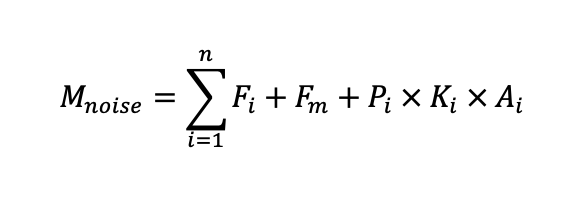
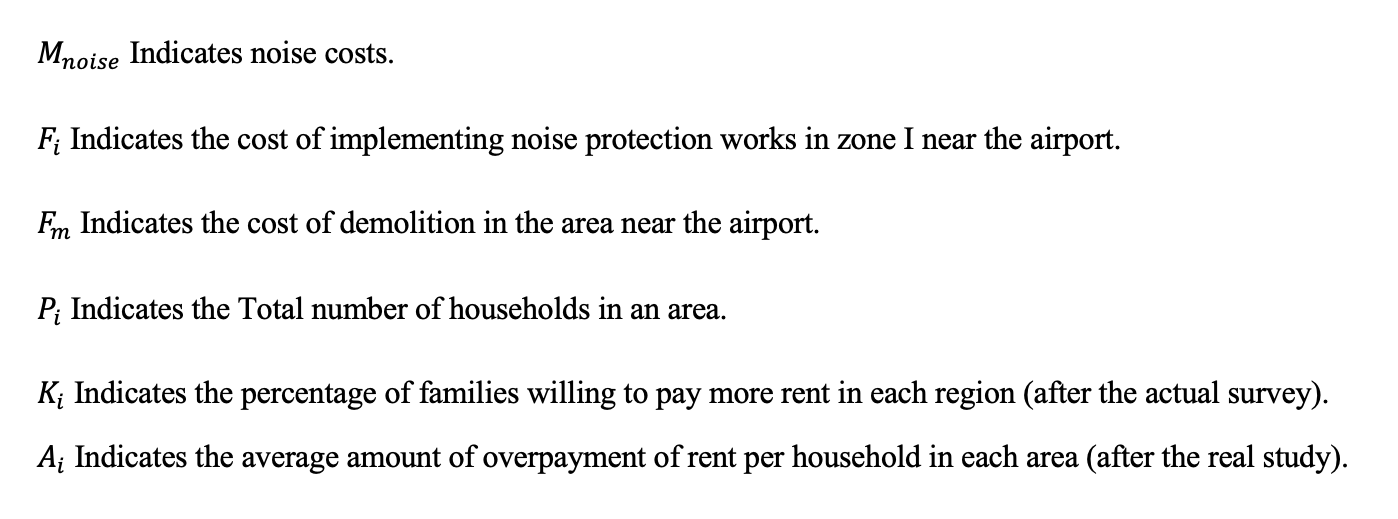
Monetization Of Erosion Costs
For the erosion generated in the project, the direct unit soil and water replacement cost method is used to calculate the replacement cost of soil and water in the area where the airport is located, which is an essential factor affecting the price of erosion, and the local government mainly determines the replacement cost of soil and water. Dai (2011) proposed the following equation in the road construction monetization model, as shown in equation:
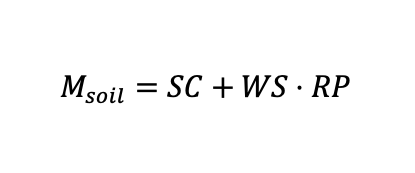
SC indicates the additional investment in soil and water conservation works
WS indicates the amount of soil erosion that will be caused by the construction of this project
RP shows the replacement cost per unit capacity of water and soil.
Monetization Of Water Pollution
The cost of wastewater treatment in the nearby plant becomes the environmental cost of water pollution. The article proposes a specific monetization formula, as shown in equation:
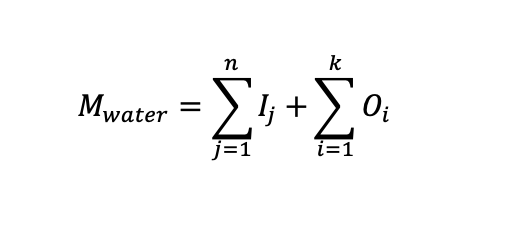

Monetization Of Land Use Change
Airport construction land can be considered permanent land, and airport construction land can also produce economic benefits. Still, due to the airport’s construction, this part of the economic benefits are reduced or even disappeared from the environmental economics theory. This also belongs to the airport construction on environmental impact (Linna Li & Loo, 2016). The ecological cost of land use change can be calculated by combining the annual output value and occupation time of each type of land occupied by the construction project. Dai (2011) proposed the following equation in the road construction monetization model, as shown in equation:
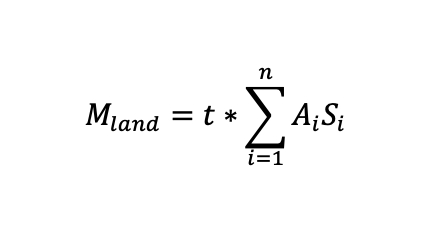
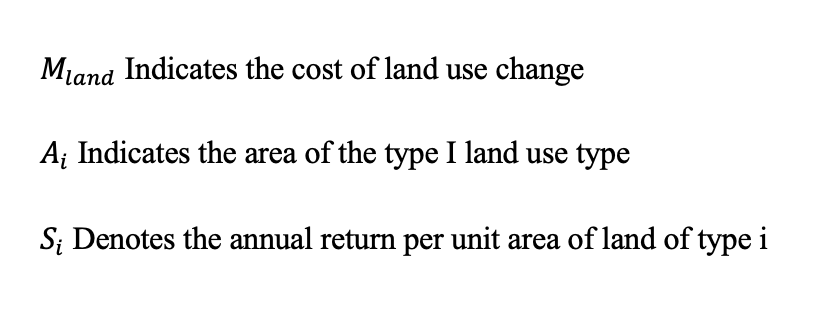
Monetization Of Vegetation Destruction
According to Dai (2011), where most revegetation occurs after airport construction, the rate of revegetation is considered in the calculation. See precisely equation (5); Dai (2011) has proposed a similar equation in calculating the cost of vegetation destruction for road construction; however, the vegetation recovery rate is not taken into account.
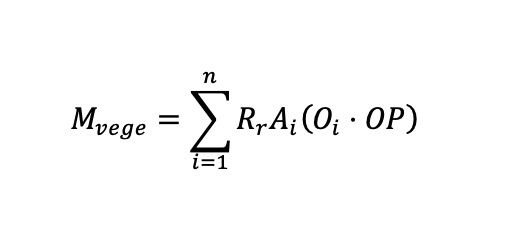
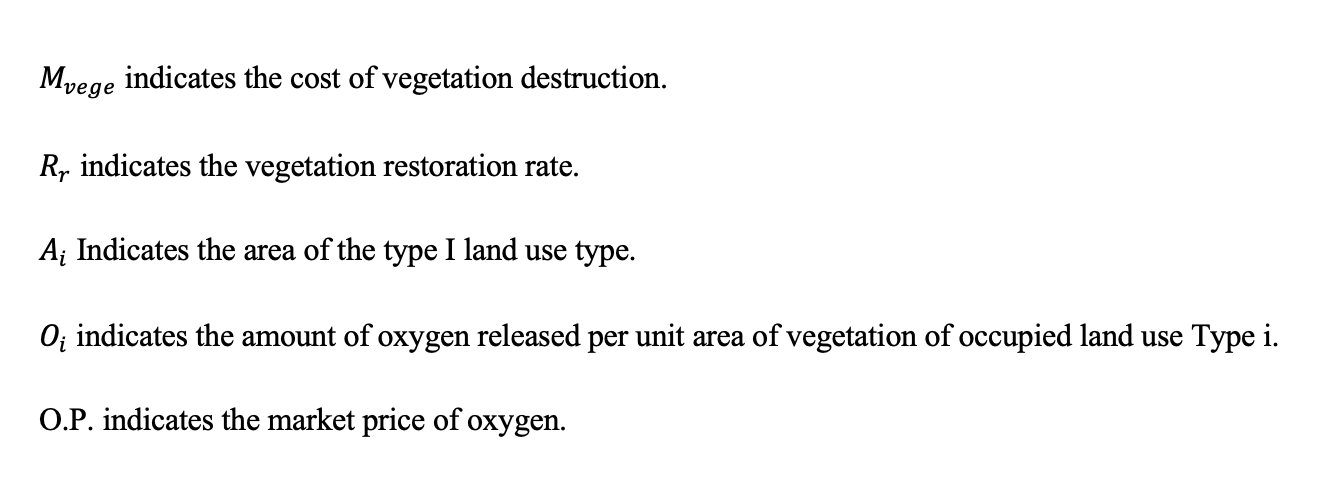
Cost Of Greenhouse Gas Emissions
Considering that aircraft burn much fuel when they take off, a Boeing 747-400, for example, consumes around five tons of energy for a single takeoff. The environmental impact of the greenhouse gases produced is not negligible. When considering how much fuel is consumed as the basis for the calculation, the aircraft type that takes off the most at that airport should be regarded as getting a relatively accurate cost of emissions. In determining the conversion factor between aviation paraffin and carbon dioxide, the carbon content of aviation paraffin is around 85%, the density of paraffin is 0.8, and the amount of carbon dioxide emitted by burning one litre of paraffin is.
0.85 × 0.8 × 44 ÷ 12 = 2.49kg
The number of aircraft departures from this airport can be determined by the number of aircraft landings and takeoffs, defined as the number of flights taking off and landing per unit of time. Suppose the sample of time required for the calculation is large enough. In that case, the number of aircraft departures can be considered equal to the number of aircraft landings, so the number of aircraft departures at the airport is half of the number of aircraft landings and takeoffs. A carbon tax is an environmental tax on certain goods or services that cause carbon dioxide emissions based on the number of emissions. The cost of greenhouse gas emissions depends on the change in the carbon tax. The carbon tax varies from region to region, from 50 euros per ton in the E.U. to around 5 euros per ton in some developing countries.
Based on the price of the carbon tax, the cost of greenhouse gas emissions from takeoff and landing can be calculated, as shown in equation:

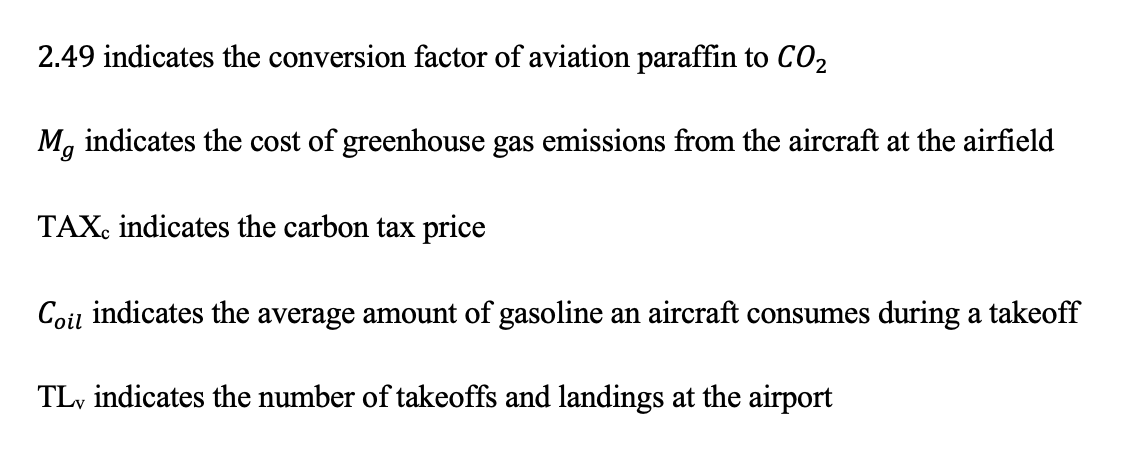
Total Environmental Cost Of Airport Construction (Including Operation)
Based on the above calculation, the formula for the total environmental cost of the airport during the construction and operation periods is shown in equation:

Monetizing environmental costs is the most widely practised practice to deter companies from polluting the environment. However, these methods are limited to the following aspects; Temel et al. (2018, p.13) in their study, found that the scale and uniqueness of an ecosystem and the level of ecosystem threat should serve as the conditions to indicate the appropriateness of the application of monetization to ecosystem services. Monetization should be used with other conservation measures, and additional measures to protect the ecosystem should be implemented. In this study, therefore, the aircraft industry should be able to operate below the WHO guidelines, failure to which stringent policies should be implemented.
Results and Discussions
Example analysis (Guangzhou Baiyun International Airport)
Guangzhou Baiyun International Airport was built in 1932, and the new Guangzhou Baiyun International Airport was officially opened on August 5, 2004. According to information on the airport’s official website in January 2020, Guangzhou Baiyun International Airport has two terminals, T1 and T2, totalling 1,817,700 square meters. Located in southern China, it overtook Atlanta Airport in the United States to become the world’s number one airport in 2020. The third phase of the Baiyun International Airport expansion project will see the construction of a third terminal designed to handle 120 million passengers, 3.8 million tons of cargo and mail, and 775,000 aircraft movements by 2030. This paper analyzes the environmental cost monetization of the Phase 3 expansion project.
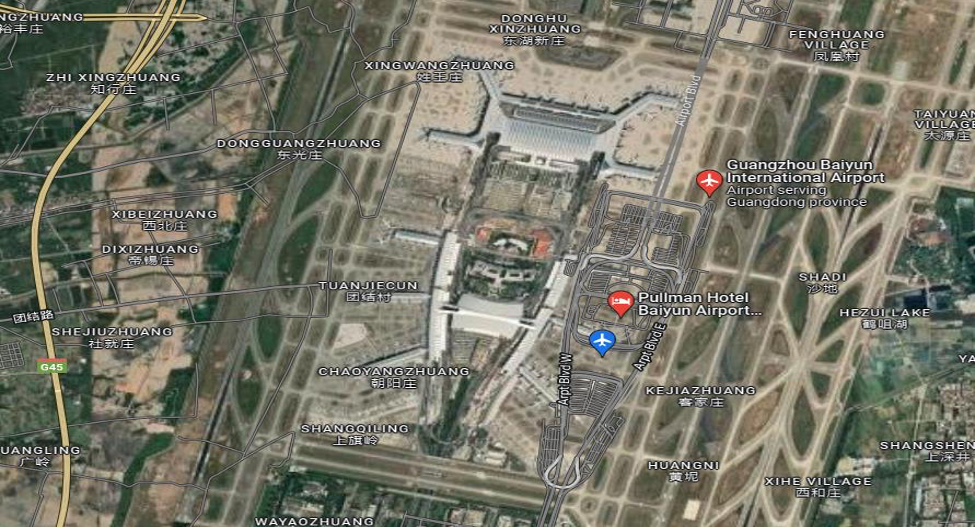
Noise Costs
According to the feasibility report of the expansion project, the total area of land to be demolished and relocated is 34.67 square kilometres, with a total of 18,000 households and 58,000 people to be relocated. The number of families resettled in the noise zone is 5,424, calculated at 200 square meters per household and 4,000 RMB per square meter; approximately 4,339,000,000 RMB will be required.
At the end of the expansion project, the residents within the 80dB range will be relocated orderly through planning, with 27778 people (7936 households at an average of 3.5 people per household) within the WECPNL of 80dB or more in 2030. Based on 200 square meters per household at 4,000 RMB per square meter, approximately 6,348.8 million RMB is required to implement the relocation plan. In 2045, 36,422 people (10,406 households at an average of 3.5 people per household) will be within the WECPNL range of more than 80dB, at 200 square meters per household at 4,000 RMB per square meter, approximately 8,324.8 million RMB will be required. Therefore, the total amount of demolition is 14.67 billion RMB.
According to the survey, the relocation area of the school and hospital is 15,716,686 square meters; at 4,000 RMB per square meter, the relocation cost is 1,182.7 million RMB 2030, there will be 85,172 people or 24,334 households in the 75-80dB range of WECPNL, and the area of windows and doors to be renovated will be 365,010 square meters, based on 1300RMB per square meter of ventilation windows, a total of 474.51 million RMB will be required. In 2045 there are 112,162 people or 32,046 households in the WECPNL 75-80dB range, with 480,690m2 of windows and doors to be altered. The total cost of implementing the noise protection project is RMB 1,099 million. Wolfe, Kramer, and Barrett (2017) found total noise damages of £80.3 million and £0.87 million attributable to Heathrow and Gatwick, respectively.
During the operation period, per this extension’s feasibility report, a survey-based approach to the valuation of non-market goods and services will be used, using questionnaires to guide the value of the goods or services concerned directly. The airport has minimized the noise impact on nearby residents through demolition or noise protection. The article conducted a noise comfort survey of nearby residents and found from a sample of nearly 30 that less than 40 percent were willing to pay extra to find alternative accommodation. Most of the sample willing to pay extra chose to be ready to pay just under RMB 200. The results show that the effect of noise on the undemolished population is low and statistically tricky, and the article chooses to ignore it.

Cost Of Soil Erosion
According to the Soil and Water Conservation Plan Report for the Phase III Expansion Project of Guangzhou Baiyun International Airport, the construction of the project may result in an additional soil loss of 209,800 tonnes, and Dai (2011) concluded that the replacement cost per tone of soil and water is 3dollar. The replacement cost of soil erosion is US$630,000. In addition, the cost of soil and water conservation fees and the preparation of the soil and water conservation facility plan during construction is RMB 51.5 million, or USD 7.7397 million.
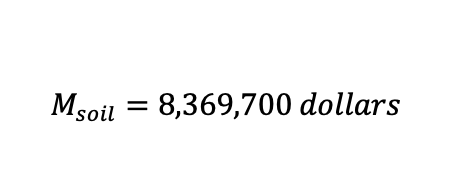
Cost Of Water Pollution
To stop water pollution, the airport has expanded the existing sewage treatment plant, with a capacity of for 36 million RMB, a new sewage network and a new sewage pumping station for 40 million RMB, and nine sewage trucks at 7.2 million RMB—83.2 million RMB in total, equivalent to 12.3 million U.S. dollars.
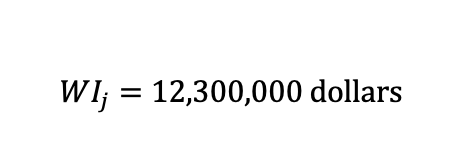
As the sewage treatment plant will not be completed immediately, and considering that there will be insufficient sewage treatment capacity even after the completion of the plant, after analysis, it is determined that the maximum daily sewage consumption of the airport in the current phase is , and the average daily sewage consumption of the airport is about ; the maximum daily sewage consumption in the long term is , so the average daily sewage consumption of the airport is about
During this period, the entire airport wastewater is discharged to the Longgui and Baiyun Airport sewage treatment plants for treatment. The volume of sewage discharged to the Longgui sewage treatment plant is 13,000 m³/d; the volume of sewage discharged to the airport sewage treatment plant is 36,000 m³/d.
The cost of discharging to the airport treatment plant should be calculated as part of the expansion cost of the treatment plant, while the cost of releasing it to other treatment plants should be calculated separately. After checking its treatment cost of 2.0 RMB per m³ per day, the treatment cost is 26,000 RMB per day, i.e., US$4,000 per day.

Land use change costs
The main phase of the Baiyun International Airport involves 166 hectares of arable land, 323 hectares of garden land, 28 hectares of forest land, and 167 hectares of other agricultural lands; this means that 685 hectares of agricultural land are converted to commercial use. In terms of environmental economics theory, the original agricultural output of the land should be calculated as an ecological cost. The average annual production value of each type of land cannot be obtained precisely. Hence, the article assumes that all agricultural land is calculated according to the area’s average agricultural land production value, that each farmer has an average of 0.5 hectares of arable land after checking, and that each farmer receives an annual agricultural income of $1642.
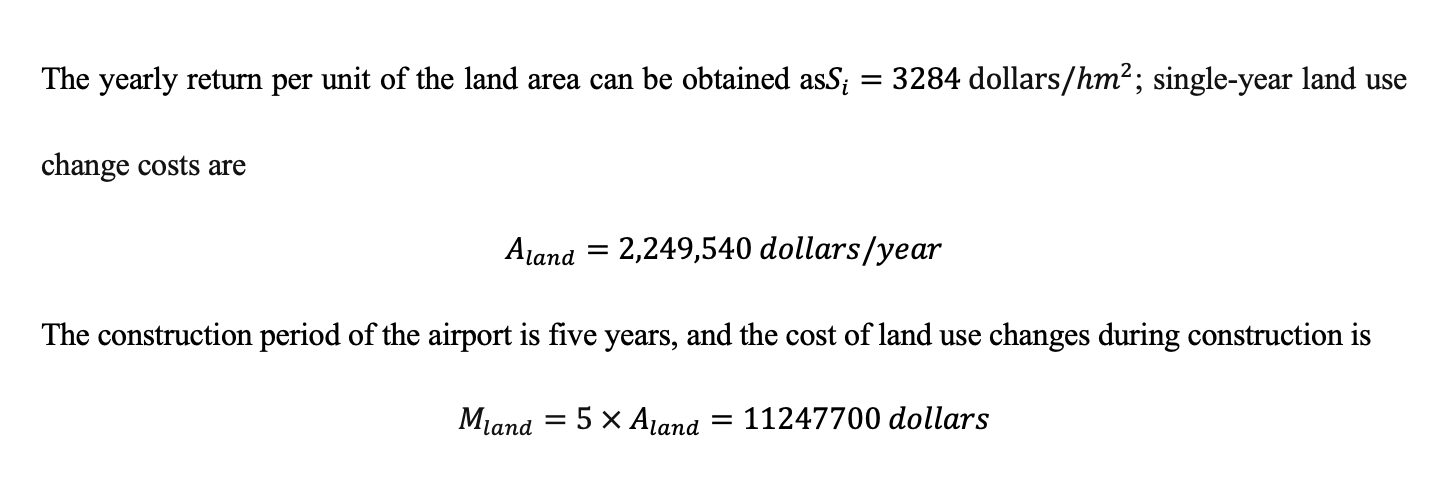
Vegetation Destruction
According to the equation for the photosynthesis reaction in plants, 1 g of dry matter is formed to produce 1.2 g of oxygen. In the various environmental assessment documents, it is impossible to find the biological loss for this expansion project since it needs to be completed. However, estimates made from other airport environmental assessment reports have improved this data. The construction of Chengdu Shuangliu International Airport resulted in the conversion of 1537 ha of arable land into airport construction land, resulting in a loss of 51,914 tons of plant biomass. It is assumed that 33.7 tonnes are lost per hectare during the airport construction. The permanent conversion of 685 ha of agricultural land to commercial use in this project is estimated to result in a biomass loss of 23,084.5 tones, resulting in a total oxygen loss of 27,701.4tonness, and Dai (2011) suggests that the market price of oxygen is $300.
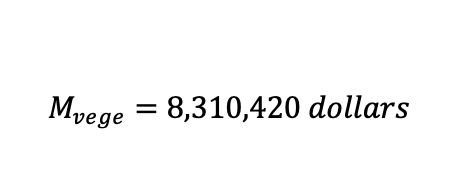
Cost of greenhouse gas emissions
The target number of aircraft movements for Phase 3 of Baiyun International Airport is 775,000. Takeoffs and landings refer to the number of flights taking off and landing per unit of time. It means that there are 387,500 aircraft departures per year. The Boeing 747-400 aircraft is China’s most numerous passenger aircraft. It can be assumed that the Boeing 747-400 is the aircraft that takes off the most at Baiyun International Airport, consuming around 5 tons of fuel for one takeoff. For ease of calculation and feasibility, it is assumed that all aircraft taking off are Boeing 747-400s, with a current Chinese carbon tax price of 7.4 dollars/ton.


Since no aircraft will take off during the construction period, no GHG emissions from aircraft will be generated. Therefore, the cost of GHG emissions should not be calculated as part of the environmental cost of the construction period.
Environmental costs during airport construction
Baiyun International Airport will be built over five years old

The environmental cost for the entire construction period is 3,240,957,820 dollars at R=2,395,540 dollars/year for the whole of the five-year construction period and 2,395,540 dollars/year for the operational period.
Discussion
Based on previous research, this paper proposes a set of environmental cost monetization models for airport construction. It uses the models to monetize the ecological costs of the Phase III expansion project of Baiyun International Airport. It is one of the world’s top ten airports, and it concludes that its monetized environmental impact is 3,240,227,820 dollars for the construction period. The annual ecological cost for the operational period is 10,70510,705,960 dollars.
This study finding in table 1 below shows the cumulative environmental costs of various environmental effects such as noise, soil erosion, water pollution, land use change costs, and emission of greenhouse gases. The findings revealed the enormous ecological fees that should be charged to the airports implementing construction and Operation to reduce the effects of greenhouse gases and climate change as the overall detrimental effects realized after the commissioning of such projects.
Table 3: Environmental Costs of China Baiyun International Airport Phase 3 Expansions
| Cost type | Construction period costs | Operating period costs |
| Noise costs | 3200,000,000 dollars | |
| Cost of soil erosion | 8,369,700 dollars | |
| Cost of water pollution | 12,300,000 dollars | 146,000 dollars/year |
| Land use change costs | 11247700 dollars | 2,249,540 dollars/year |
| Vegetation destruction | 8,310,420 dollars | |
| Cost of greenhouse gas emissions | 35,700,000 dollars/year | |
| Total cost | 3,240,227,820 dollars | 10,705,960dollars/year |
The study finding agreed with Temel et al. (2018) that monetizing environmental costs is critical to enhancing environmental conservation projects of the affected communities. However a new concept, but the insights of Linna Li& Yo (2016) in their study found that despite the environmental costs of airport construction, it is essential to consider the economic costs associated with the project. Welsch, Heinz, and Jan Kühling (2009) should be incorporated this when conducting the valuation of environmental costs. Nahlik et al. (2016) assert that the airline industry’s growth has massive economic benefits to the communities. In their research, Yim, Stettler, and Barrett (2013) propose that widespread longer-term use of biomass-derived alternative jet fuels could further increase the mitigation potential. Other measures can be introduced to curb environmental costs through recycling and reuse. And the reduction of waste during the construction and operation processes. Airline industries can also adopt different engines that do not have a high combustion rate, to reduce the emission of greenhouse gases. The models used in this study are transferable to other sectors of the economy, where the ability to pay is considered.
The study finding also was in tandem with Rikkie et al., (2015) study which found that though there were existing monetization models to calculate the environmental costs associated with the aviation industry, it noted that the hedonic principles were ignored. In this study, it is evident that the author is only concerned with the monetization models, without looking into the direct and indirect impacts caused by the project on the stakeholders. The variation in the methodologies used by economists in valuing environmental costs should be standardized.
Conclusion
The study shows how a systematic monetization model can be used in calculating the environmental costs of different aspects of the project. The costs can be used for various ecological regenerating activities by ensuring that the airport owners pay pollution tax to mitigate the effects caused by their development activities. The models provided can provide a reference for the magnitude of the environmental impact of airport construction and will provide a more comprehensive decision-making tool for the public and policymakers. Airport expansion projects offer environmental experts a chance to improve the effects of pollution by implementing innovations of less harmful fuels in the airline industries and minimizing toxic substances. This thesis builds on previous monetization studies to develop a set of monetized models for estimating environmental costs of airport construction and Operation based on practical approaches in ecological economics to incorporate environmental costs into the cost-benefit analysis of airport construction.
References
Anthoff, D., Tol, R.S.J. and Yohe, G.W. (2009) Risk aversion, time preference, and the social cost of carbon. Environmental Research Letters, 4 (2): 024002. doi:10.1088/1748-9326/4/2/024002.
Anon., 2016. Study on the impact of airport construction on the surrounding environment – Ankang airport project as an example. Journal of Northwestern University: Natural Sciences Edition, 6 4.
Arendt, R., Bachmann, T.M., Motoshita, M., et al. (2020) Comparison of Different Monetization Methods in L.C.A.: A Review. Sustainability, 12 (24): 10493. doi:10.3390/su122410493.
Arter, C.A., Buonocore, J.J., Moniruzzaman, C., Yang, D., Huang, J. and Arunachalam, S., 2022. Air quality and health-related impacts of traditional and alternate jet fuels from airport aircraft operations in the U.S. Environment International, 158, p.106958.
Ashok, A., Dedoussi, I.C., Yim, S.H., Balakrishnan, H. and Barrett, S.R., 2014. Quantifying the air quality-CO2 tradeoff potential for airports. Atmospheric environment, 99, pp.546-555.
Bein, P. and Kawczynski, M. (1997) Environmental Accounting in Greater Vancouver Transportation System Planning. Transportation Research Record, 1601 (1): 13–20. doi:10.3141/1601-03
Chen, L., 2018. Estimating the Monetary Value of Marine Environmental Pollution Losses – The Case of the Pearl River Estuary. MARINE ECONOMY, 27 12, p. 8.
Dai, Y., 2011. Study on Monetization Model of Environmental Costs of Road Transportation. Environmental protection Science, 27 9, p. 69.
Faisal, F., Fatihah, A., Aprilia, S. and Wiliyanda, W., 2020. Smart Airport Model Implementation as A Tourist Attraction in West Java International Airport Kertajati. Digital Press Social Sciences and Humanities, 4, p.00008.
Feng, S., 1997. Comfort impact assessment and economic loss analysis of airport noise pollution. 12 11.
Flowerdew, A., 1972. The Cost of Airport Noise. The Statistician, 21(1), p.31.
Givoni, M. and Rietveld, P., 2010. The environmental implications of airlines’ choice of aircraft size. Journal of Air Transport Management, 16(3), pp.159-167.
Gilchrist, A. and Allouche, E.N. (2005) Quantification of social costs associated with construction projects: a state-of-the-art review. Tunnelling and Underground Space Technology, 20 (1): 89–104. doi:10.1016/j.tust.2004.04.003.
Greer, F., Horvath, A. and Rakas, J. (2023) Life-Cycle Approach to Healthy Airport Terminal Buildings: Spatial-Temporal Analysis of Mitigation Strategies for Addressing the Pollutants that Affect Climate Change and Human Health. Transportation Research Record: Journal of the Transportation Research Board, 2677 (1): 797–813. doi:10.1177/03611981221101896.
Helbig, T., Scheible, F., Kamp, F. and Schieber, R., 2014. Engineering in a computational design environment – New Terminal 3 at Shenzhen Bao’an International Airport, China. Steel Construction, 7(1), pp.24-31.
Istamto, Houthuijs, and Lebret, E., 2009. Monetization Review on Environmental Health Effects in Health Impact Assessments/HIA. Epidemiology, 20, p.S18. Foreign Language Science and Technology Journal Database Economic Management, 2020. Airport Construction and Regional Economic Development.
ITSUBO, N., 2007. Monetization of Environmental Impacts and Application Environmental Economics to LCIA. Journal of Life Cycle Assessment, Japan, 3(1), pp.80-86. Gf.gzggzy.cn. 2022. [online] Available at: <https://gf.gzggzy.cn/gz1/M00/05/30/CsUnsV8RVWuAUkEjAevZgohA6HQ966.pdf> [Accessed August 27 2022].
Linna Li & Becky P. Y. Loo . 2016. Impact analysis of airport infrastructure within a sustainability framework: Case studies on Hong Kong International Airport, International Journal of Sustainable Transportation, 10:9, 781-793, DOI: 10.1080/15568318.2016.1149647
Jia, X., 2017. Quantitative Analysis of Marine Ecological Loss. Advances in Marine Sciences, 04(03), pp.96-101.
Thanos, S., Wardman, M. and Bristow, A., 2011. Valuing Aircraft Noise: Stated Choice Experiments Reflecting Inter-Temporal Noise Changes from Airport Relocation. Environmental and Resource Economics, 50(4), pp.559-583.Kirkuk University Journal-Scientific Studies, 2020. https://kujss.iraqjournals.com/pdf_166170_8dd024058ce4abb6c364bec514cecef8.html. 15(2), pp.1-16. Anthoff, D., Tol, R.S.J. and Yohe, G.W. (2009) Risk aversion, time preference, and the social cost of carbon. Environmental Research Letters, 4 (2): 024002. doi:10.1088/1748-9326/4/2/024002.
Arendt, R., Bachmann, T.M., Motoshita, M., et al. (2020) Comparison of Different Monetization Methods in L.C.A.: A Review. Sustainability, 12 (24): 10493. doi:10.3390/su122410493.
Arter, C.A., Buonocore, J.J., Moniruzzaman, C., et al. (2022) Air quality and health-related impacts of traditional and alternate jet fuels from airport aircraft operations in the U.S. Environment International, 158: 106958. doi:10.1016/j.envint.2021.106958.
Bein, P. and Kawczynski, M. (1997) Environmental Accounting in Greater Vancouver Transportation System Planning. Transportation Research Record, 1601 (1): 13–20. doi:10.3141/1601-03.
Gilchrist, A. and Allouche, E.N. (2005) Quantification of social costs associated with construction projects: state-of-the-art review. Tunnelling and Underground Space Technology, 20 (1): 89–104. doi:10.1016/j.tust.2004.04.003.
Greer, F., Horvath, A. and Rakas, J. (2023) Life-Cycle Approach to Healthy Airport Terminal Buildings: Spatial-Temporal Analysis of Mitigation Strategies for Addressing the Pollutants that Affect Climate Change and Human Health. Transportation Research Record: Journal of the Transportation Research Board, 2677 (1): 797–813. doi:10.1177/03611981221101896.
Nahlik, M.J., Chester, M.V., Ryerson, M.S., et al. (2016) Spatial Differences and Costs of Emissions at U.S. Airport Hubs. Environmental Science & Technology, 50 (8): 4149–4158. doi:10.1021/acs.est.5b04491.
Nguyen, T., Laratte, B., Guillaume, B. and Hua, A., 2016. Quantifying environmental externalities with a view to internalizing them in the price of products, using different monetization models. Resources, Conservation and Recycling, 109, pp.13-23.
Pecorari, E., Mantovani, A., Franceschini, C., et al. (2016) Analysis of the effects of meteorology on aircraft exhaust dispersion and deposition using a Lagrangian particle model. Science of The Total Environment, 541: 839–856. doi:10.1016/j.scitotenv.2015.08.147.
Pizzol, M., Weidema, B., Brandão, M., et al. (2015) Monetary valuation in Life Cycle Assessment: a review. Journal of Cleaner Production, 86: 170–179. doi:10.1016/j.jclepro.2014.08.007.
Rahmawati, R., Sebayang, A. and Julia, A., 2020. Readiness of Culinary Micro, Small and Medium Enterprises to Support the Development of West Java International Airport (WJIA) Kertajati (Case Study: Kertajati Village, Kertajati District, Majalengka Regency-Indonesia). Dinamika Ekonomi, 12(1), pp.88-95.
Shen, Y., Wu, Y., Chen, G., Van Grinsven, H., Wang, X., Gu, B. and Lou, X., 2017. Non-linear increase of respiratory diseases and their costs under severe air pollution. Environmental pollution, 224, pp.631-637.
Siping, J., Wendai, L., Liu, M., Xiangjun, Y., Hongjuan, Y., Yongming, C., Haiyun, C., Hayat, T., Alsaedi, A. and Ahmad, B., 2019. Decoupling environmental pressures from economic growth based on emissions monetization: Case in Yunnan, China. Journal of Cleaner Production, 208, pp.1563-1576.
Temel, J., Jones, A., Jones, N., & Balint, L. 2018. Limits of monetization in protecting ecosystem services. Conservation Biology. doi:10.1111/cobi.13153.
Verhoef, E., 1994. External effects and social costs of road transport. Transportation Research Part A: Policy and Practice, 28(4), pp.273-287.
Welsch, Heinz, and Jan Kühling. “Using happiness data for environmental valuation: issues and applications.” Journal of Economic Surveys 23, no. 2 (2009): 385-406.
Wolfe, P.J., Kramer, J.L. and Barrett, S.R., 2017. Current and future noise impacts of the U.K. hub airport. Journal of Air Transport Management, 58, pp.91-99.
Wolfe, P.J., Yim, S.H., Lee, G., Ashok, A., Barrett, S.R. and Waitz, I.A., 2014. Near-airport distribution of the environmental costs of aviation. Transport Policy, 34, pp.102-108
Yao, F., Liu, G., Ji, Y., Tong, W., Du, X., Li, K., Shrestha, A. and Martek, I., 2020. Evaluating the environmental impact of construction within the industrialized building process: a monetization and building information modeling approach. International Journal of Environmental Research and Public Health, 17(22), p.8396.
Ye, F., Huang, X., Shi, Z., and Chen, B., 2021. The spatial distribution of benthic foraminifera in the Pearl River Estuary, South China, and its environmental significance. Marine Pollution Bulletin, 173, p.113055.
Yim, S.H., Stettler, M.E. and Barrett, S.R., 2013. Air quality and public health impacts of U.K. airports. Part II: Impacts and policy assessment. Atmospheric environment, 67, pp.184-192.
Zhang, X., Song, W., Wang, J., Wen, B., Yang, D., Jiang, S. and Wu, Y., 2020. Analysis of Decoupling between Urbanization Level and Urbanization Quality in China. Sustainability, 12(17), p.6835.
 write
write